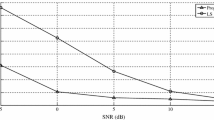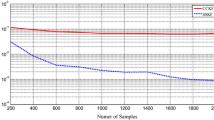Abstract
In this paper, we propose a time-varying vector two-sided autoregressive (VTAR) model for time–frequency analysis of multichannel signals. The multichannel approach is suitable in many applications, such as electroencephalogram analysis and spatial data processing, where the signals are recorded from several sensors, giving rise to vector or multichannel processes. In VTAR modeling, the current sample of the signal in some channel is estimated by a symmetrically weighted sum of past and future samples of this channel as well as of the other channels. The multidimensional VTAR parameters are assumed to be time varying and they are modeled as a linear combination of a set of basis functions. The recursive least-squares algorithm is used to estimate the coefficients of the linear combination. The VTAR model requires a smaller order than the conventional vector autoregressive (VAR) model to achieve better resolution in the time–frequency plane. Numerical examples are given in order to compare the VTAR-based time–frequency distribution with the conventional VAR-based time–frequency distribution and the Choi–Williams distribution.
Similar content being viewed by others
References
M. Arnold et al., Adaptive AR Modeling of Nonstationary Time Series by Means of Kalman Filtering, IEEE Trans. Biomed. Eng., 45(5), pp. 553–562, 1998.
B. Boashash, Time-frequency analysis, in: S. Haykin (ed.), Advances in Spectrum Estimation, Prentice-Hall, Englewood Cliffs, NJ, 1990, pp. 418–517.
B. Boashash and V. Sucic, Resolution Measure Criteria for the Objective Assessment of the Performance of Quadratic Time-Frequency Distributions, IEEE Trans. Signal Processing, 51(5), pp. 1253–1263, 2003.
R. Charbonnier, M. Barlaud, G. Alengrin, and J. Menez, Results on AR-modeling of Nonstationary Signals, Signal Processing, 12(2), pp. 143–151, 1987.
H. I. Choi and W. J. Williams, Improved Time-Frequency Representation of Multicomponent Signals Using Exponential Kernels, IEEE Trans. Acoust. Speech Signal Processing, 37(6), pp. 862–871, 1989.
L. Cohen, Time-Frequency Distribution – A Review, Proceedings of the IEEE, 77(7), pp. 941–981, 1989.
S. Conforto and T. D’alessio, Spectral Analysis of Nonstationary Signals from Mechanical Measurements: A Parametric Approach, Mec. Sys. Signal Processing, 13(3), pp. 395–411, 1999.
S. Conforto and T. D’alessio, Optimal Estimation of Power Spectral Density by Means of a Time-Varying Autoregressive Approach, Signal Processing, 72(1), pp. 1–14, 1999.
S. D. Cranstoun et al., Time-Frequency Spectral Estimation of Multichannel EEG using the Auto-SLEX Method, IEEE Trans. Biomed. Eng., 49(9), pp. 988–996, 2002.
M. Elling and P. Sherman, A Kalman Filter Based Approach for Estimating Nonstationary VAR Models via Pole Tracking, Proceedings of the IEEE ICASSP, pp. 685–688, 2000.
K. B. Eom, Analysis of Acoustic Signatures from Moving Vehicles Using Time-Varying Autoregressive Models, Multidimensional Systems and Signal Processing, 10, pp. 357–378, 1999.
B. Friedlander and B. Porat, Multichannel ARMA Spectral Estimation by the Modified Yule-Walker Method, Signal Processing, 10(1), pp. 49–59, 1986.
W. Gersch, A. Gevins, and G. Kitagawa, A Multivariate Time-Varying Autoregressive Modeling of Nonstationary Covariance Time Series, Proceedings of the 22nd IEEE Conf. Decis. Cont., pp. 579–584, 1983.
W. Gersch and D. Stone, Multichannel Time-Varying Autoregressive Modelling: A Circular Lattice-Smoothness Priors Realization, Proceedings of the 29th IEEE Conf. Decis. Cont., pp. 859–860, 1990.
Y. Grenier, Time-Dependent ARMA Modeling of Nonstationary Signals, IEEE Trans. Acoust. Speech Signal Processing, 31(4), pp. 899–911, 1983.
Y. Grenier, Modèles ARMA à coefficients dépendant du temps: estimateurs et applications, Traitement du Signal, 3(4–5), pp. 219–233, 1986.
M. G. Hall, A. V. Oppenheim, and A. S. Willsky, Time-Varying Parametric Modeling of Speech, Signal Processing, 5(3), pp. 267–285, 1983.
M. K. Hasan, M. J. Hossain, and M. A. Haque, Parameter Estimation of Multichannel Processes in Noise, Signal Processing, 83(3), pp. 603–610, 2003.
S. Haykin, Adaptive Filter Theory, Prentice-Hall, Englewood Cliffs, NJ, 1991, Chapter 13, pp. 477–507.
F. Hlawatsch and G. F. Boudreaux-Bartels, Linear and Quadratic Time-Frequency Signal Representations, IEEE Signal Processing Magazine, 9(2), pp. 21–67, 1992.
J. Hsu and A. E. Yagle, Fast Algorithms for Close-to-Toeplitz-Plus-Hankel Systems and Two-Sided Linear Prediction, IEEE Trans. Signal Processing, 41(7), pp. 2349–2361, 1993.
J. Hsu and A. E. Yagle, Blind Deconvolution of Symmetric Noncausal Response Using Two-Sided Linear Prediction, IEEE Trans. Signal Processing, 42(6), pp. 1509–1517, 1994.
J. Hsu and A. E. Yagle, Similarities and Differences Between One-Sided and Two-Sided Linear Prediction, IEEE Trans. Signal Processing, 43(1), pp. 345–349, 1995.
A. Isaksson, A. Wennberg, and L. H. Zetterberg, Computer Analysis of EEG Signals with Parametric Models, Proceedings of the IEEE, 69(4), pp. 451–461, 1981.
X. Q. Jiang and G. Kitagawa, A Time-Varying Coefficient Vector AR Modeling of Nonstationary Covariance Time Series, Signal Processing, 33(3), pp. 315–331, 1993.
R. H. Jones, Identification and Autoregressive Spectrum Estimation, IEEE Trans. Aut. Cont., 19(6), pp. 894–898, 1974.
A. Kacha, F. Grenez, and K. Benmahammed, Time-Frequency Analysis and Instantaneous Frequency Estimation Using Two-Sided Linear Prediction, Signal Processing, 85(3), pp. 491–503, 2005.
S. M. Kay, Modern Spectral Estimation: Theory and Application, Prentice-Hall, Englewood Cliffs, NJ, 1988, Chapter 14, pp. 446–478.
F. Kozin and F. Nakajima, The Order Determination Problem for Linear Time-Varying AR Models, IEEE Trans. Aut. Cont., vol. 25(2), pp. 250–257, 1980.
A. C. Lee, A New Autoregressive Method for High-Performance Spectrum Analysis, J. Acoust. Soc. Amer., 86(1), pp. 150–157, 1989.
T. Leou and J. K. Aggarwal, Recursive Implementation of LTV Filters—Frozen-Time Transfer Function Versus Generalized Transfer Function, Proceedings of the IEEE, 72(7), pp. 980–981, 1984.
S. L. Marple Jr, Digital Spectral Analysis with Applications, Prentice-Hall, Englewood Cliffs, NJ, 1987, Chapter 15, pp. 386–431.
E. Möller, B. Schack, M. Arnold, and H. Witte, Instantaneous Multivariate EEG Coherence Analysis by Means of Adaptive High-Dimensional Autoregressive Models, J. Neuroscience Methods, 105(2), pp. 143–158, 2001.
M. Morf, A. Vieira, D. T. L. Lee, and T. Kailath, Recursive Multichannel Maximum Entropy Spectral Estimation, in: D. Childers (ed.), Modern Spectral Analysis, IEEE Press, San Diego, CA, 1978, pp. 172–181.
M. Niedzwiecki, Identification of Time-Varying Processes, Wiley, New York, 2000.
M. J. Paulik, N. Mohankrishnan, and M. Nikiforuk, A Time-Varying Vector Autoregressive Model for Signature Verification, Proceedings of the IEEE ICASSP, pp. 1395–1398, 1995.
B. G. Quinn, Order Determination for a Multivariate Autoregression, J. Royal Stat. Soc. (B), 42(2), pp. 182–185, 1980.
G. Schwarz, Estimating the Dimension of a Model, The Annals of Statistics, 6(2), pp. 461–464, 1978.
J. K. Tugnait, Modeling and Identification of Symmetric Noncausal Impulse Responses, IEEE Trans. Acoust. Speech Signal Processing, 34(5), pp. 1171–1181, 1986.
R. A. Wiggins and E. A. Robinson, Recursive Solution to the Multichannel Filtering Problem, J. Geophys. Res., 70(8), 1885–1891, 1965.
Author information
Authors and Affiliations
Corresponding author
Rights and permissions
About this article
Cite this article
Kacha, A., Grenez, F. & Benmahammed, K. Time–Frequency Analysis of Multichannel Signals Using Two-Sided Autoregressive Modeling. Circuits Syst Signal Process 27, 309–330 (2008). https://doi.org/10.1007/s00034-008-9032-0
Received:
Revised:
Published:
Issue Date:
DOI: https://doi.org/10.1007/s00034-008-9032-0




